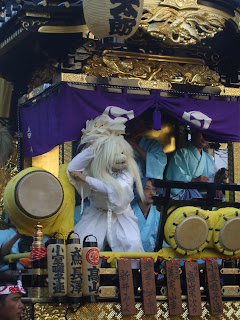 祭り
祭りMatsuri, The Traditional Japanese Festival
Before coming to Japan I knew very little if anything about Matsuri 、Japan`s Traditional community festivals, but it has come to be one of my favorite aspects of Japanese culture. Matsuri are held all throughout the year to celebrate a whole range of subjects, such as the solstice 、changing of the seasons, historical events and just about anything. There are national festivals celebrated by everyone, and most communities has local festivals also. Some of them date back hundreds of years, and some are very new, having been stared in the last few years.
Because Saitama city is the result of the amalgamation of many former cities, there are several annual festivals held here. I got to experience the Omiya and Iwatsuki Matsuri and the newly formed Saitama city matsuri. Iwatsuki is famous in Japan for traditional Dolls, and as a result the Iwatsuki Matsuri is a doll festival, which includes a huge replica of the traditional Japanese doll wedding arrangement, but with real people. There is a competition and the winning couple gets to have their wedding at the festival, dressed as traditional dolls.
 Iwatsuki Matsuri
Iwatsuki MatsuriThe Saitama citizens festival has only been around for a few years, since the formation of the city, and is a Dragon festival, with each ward entering a dragon float which is paraded around the Super Arena area. I had the great opportunity of participating in the festival, and helped carry the giant 80m Snake (gunnies record for longest bamboo snake). Great fun! But I had a sore throat for days from yelling Washoi (kind of like,
heave ho I guess) for hours at the top of my lungs.
heave ho I guess) for hours at the top of my lungs.

Me at Saitmatsuri with one BIG snake
By far the most entertaining and oldest Matsuri I went to was in the nearby city of Kawagoe and has a rich history dating back many centuries. The festival involves parading giant Dashi, wodden carts covered in ornaments. The cart usually has a large doll on the roof, and houses a band of small drums and a traditional flutes, as well as a single masked actor. There are dozens of Dashi that parade around the streets, playing music. If two of the Dashi should meet along the way, they have a musical battle, each one trying to put the other off beat. The Masked actors also have a mock battle, trying to intimidate the other with dancing and miming. It is an amazing sight to see these 16m tall wooden carts dueling, and the actors can often be quite hilarious.
 Two Dashi mid-duel at Kawagoe Festival
Two Dashi mid-duel at Kawagoe Festival A full scale Dashi
A full scale DashiIf you ever get a chance to go to be sure to try and get to a Matsuri if you have the chance, you wont regret it.




 Another very impressive site was the two
Another very impressive site was the two 

